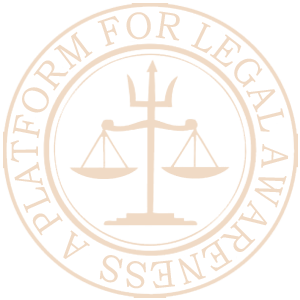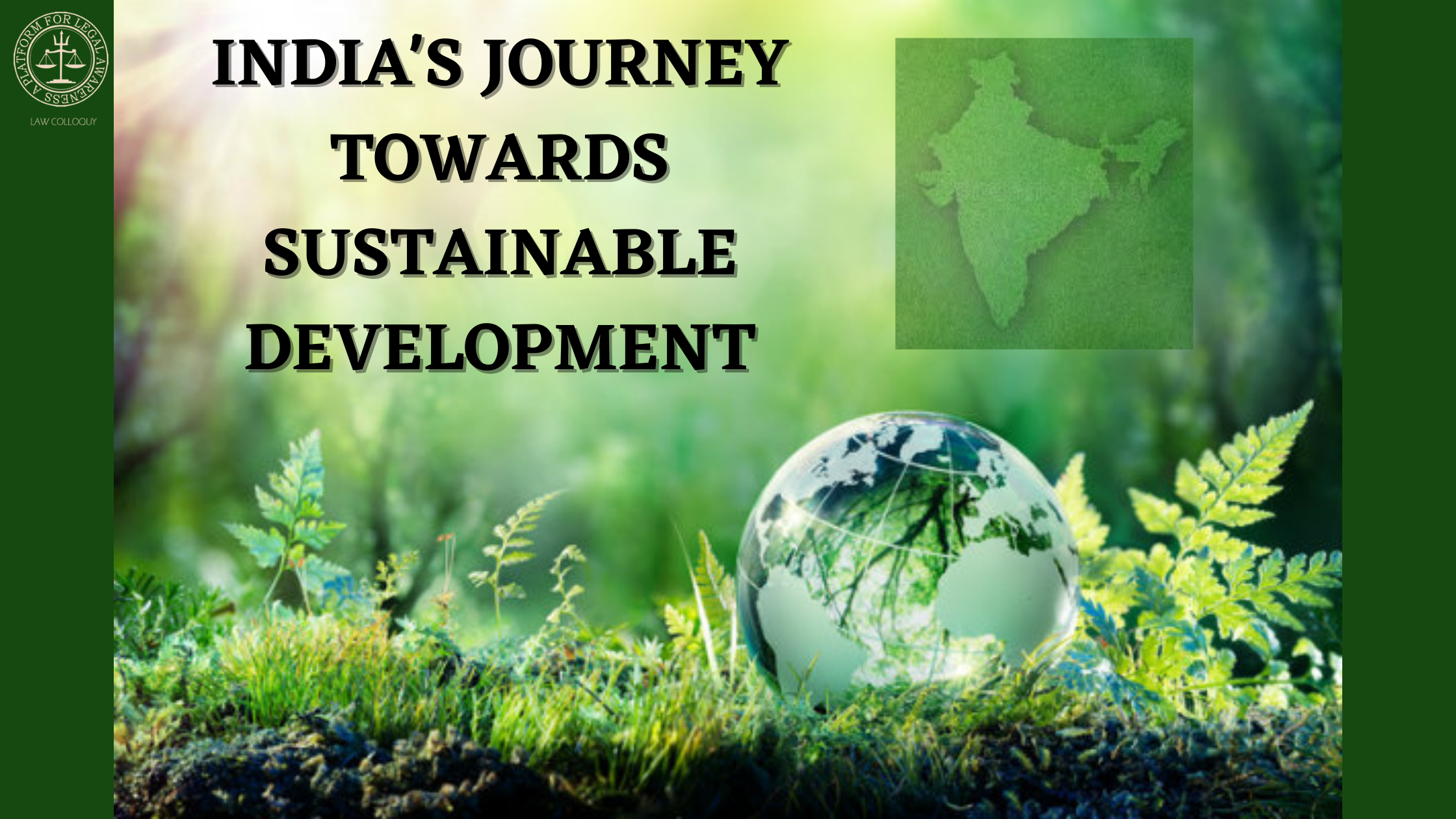INTRODUCTION
India is a developing country, and it is a territorial land with enormous amounts of natural resources in every part. Most of the resources for which many nations are conflicting are present in the Indian subcontinent in plenty.
The issue that concerns them most is the increasing growth rate in the population, leading to the depletion of these natural resources. Secondly, the lack of proper measures being taken up by the concerned legal and political authorities for the conservation of these resources has now led to the development of a new concept known as Sustainable Development.
The UN has defined sustainable development as the development that meets the needs of the present without compromising the ability of future generations to meet their own needs.
Many legal and socio-economic changes have been made since the introduction of sustainable development in India. Also, awareness programmes relating to the upliftment of the Sustainable development goals (SDG) holds the ground in the global arena of development with ideal methods.
Hence, it is essential to understand the concept of Sustainable development in the Indian context and its future targets to overcome the basic issues that include Gender Inequality, Poverty and Health.
SUSTAINABLE DEVELOPMENT GOALS
In his speech at the United Nations Sustainable Development Summit, the honourable Prime Minister Narendra Modi rightly quoted that "Much of India's development agenda is mirrored in the Sustainable Development Goals." It clearly shows the possible way forward that India being a developing country, needs to evolve some methods which would help in the sustainable development of the country. Removing poverty and encouraging prosperity in this advancing world is one of the issues which has been appreciated.
Formulation of NITI Aayog can be considered as one of the most leading steps towards achieving various SDG's. Instituted in 2015, its main aim is to design strategic and long-term policies and programmes for the Government of India. The NITI Aayog has also carried out a detailed analysis of the Developmental Goals and targets of the Centrally Sponsored Schemes, Nodal Central Ministries and major Governmental initiatives.
Drafting eco-friendly policies or saying 'Nation-friendly policies' following the viable and resourceful techniques will accelerate the Sustainable development of the nation without any reasonable doubt.
Some of the significant SDGs which have been focussed upon by India are -
• Eradicating poverty in all its forms
• End hunger, achieve food security and improved nutrition and promote sustainable agriculture
• Ensure inclusive and equitable quality education and promote lifelong learning opportunities for all
• Achieve Gender Equality and Empower all woman's and girls
• Ensure access to affordable, reliable, sustainable and modern energy for all
LEGAL AND SOCIO-ECONOMIC IMPACT ON SDG
Sustainable, Legal, Social and Economic development can be considered the nation's developmental process's founding pillars. To establish a link between the following terms and the impact on each other, some considerations need to be understood.
Considering the fact that Sustainable Development reduces the stress level on the environment, it implies that consistent growth in the economy will occur because both are interdependent. On the one hand, when the natural resources are used more reasonably, it affects the import and export of the nation which indirectly improves the reserves of the government and hence, affecting the economy in a positive sense.
As of the legal framework contributing to this concept, guidelines have been set up to conduct nationwide surveys to collect the data and ensure that the fundamental principles of sustainable development are duly accomplished. The government has also instituted the State Action Plans on Climate Change (SAPCC). India being a federal state, it is the paramount duty of the state to protect the climate from the unexpected changes in it due to exploitation of the resources.
The state government have drafted climate strategies aligned with the eight National Missions under the NAPCC. The most recent strategy covers 2015-2020 and focuses on issues ranging from climate mitigation, energy efficiency, and resource conservation to climate adaptation.
GLOBAL IMPACT ON INDIA
The concept of Sustainable Development is a debatable topic across the world. The Stockholm declaration can be considered the first global initiative by the United Nations to safeguard the rights of future generations by compromising the use of natural resources by the current generation.
It was held in the year 1972, where 26 principles were laid down. Since then, India, being a part of this declaration, implemented many rules and regulations in the form of various acts and statutes. Although non-binding and cannot be imposed upon yet, it is the moral duty of the state to introduce this concept in their own countries.
Overcoming poverty, providing proper health facilities and eradicating Gender Inequalities can be seen as challenging issues on the national level.
Due to the increased level of pollution in the nation and certain incidents such as The Bhopal Gas Tragedy and The Oleum Gas Leak Case, the global image somewhat deteriorated. Absolute Liability Doctrine, which was introduced after the Oleum gas Leak case, means that the defense of negligence cannot be taken. It is the owner/occupier's absolute responsibility to take care of the environment and take all the required safety measures beforehand proved to be a landmark theory. It not only helped in improving the environmental conditions but also made people conversant with the Sustainable development Goals.
India has also ratified the Paris agreement under the UNFCCC (United Nations Framework Convention on Climate Change). One of its important focus was upon the regularity of temperature and therefore, the Indian government introduced some guidelines for the preparation of action plan-prevention and management of heatwaves.
The table below shows the increase in the rate of deaths due to heatwaves in the country. Such data types clearly establish an immediate need to develop legal boards and increase public awareness to reduce the death count. Secondly, India also frames an image of a backpedalled country to cope with such scenarios, which automatically brings it under pressure from the eminent global platforms.
| Year | No. of Deaths |
| 2000 | 534 |
| 2001 | 505 |
| 2002 | 720 |
| 2003 | 807 |
| 2004 | 756 |
| 2005 | 1075 |
| 2006 | 754 |
| 2007 | 932 |
| 2008 | 616 |
| 2009 | 1071 |
| 2010 | 1274 |
| 2011 | 793 |
| 2012 | 1247 |
| 2013 | 1216 |
| 2014 | 1677 |
| 2015 | 2422 |
CURRENT SCENARIO
Revolutionary changes can be observed in recent years in India while observing the accomplishments in the field of achieving SDGs. SDG index score of India is 57 , which is quite good. NITI Aayog is playing a vital role in the implementation of the SDGs. The NITI Aayog is performing following functions:
• Mapping of schemes and departments
• Capacity development
• Funding and Financing
• SDG dashboard monitoring
The current government's main focus is upon the basic issues that are proving to be a hurdle in the development of the nation, which includes poverty and health. The Swachh Bharat Abhiyan was an important step towards improving the cleanliness of the environment and indirectly improving the health conditions. Poverty, although, remains a challenging issue in the Indian subcontinent.
FUTURE TARGETS AND DEVELOPMENTAL IDEAS
From the above discussions, two broad aspects can be made out from the concept of Sustainable Development:
• In terms of the environment
• In terms of Nationwide developmental issues (poverty, health etc.)
2030 is the deadline for achieving the sustainable development goals taken up by the government of India.
Environmental laws are now taken more seriously and stricter actions and penalties are imposed on the wrong-doers. Reducing Air Pollution is one of the most challenging tasks yet to be completed.
Environmental Impact Assessment, an initiative to cope-up with the industrial pollution threat in advance, needs to be implemented more seriously and slightest opportunities of corruption in this field should be condemned.
Schemes like Pradhan Mantri Mudra Yojana and the Start-up India program give the opportunities of the young generation to earn and fight against poverty. MSME Projects are also given more significance to encourage people to start up a new business. It is important to develop the small-scale industry because most people indulge in this sector and need a supportive mechanism.
The Atal Pension Yojana for the senior citizens and Pradhan Mantri Jeevan Jyoti Bima Yojana have helped safeguard the health of the citizens of the nation. Introducing schemes is an easier task than correctly implementing them.
The very existence of laws guarantees that administrative agencies shall be efficient and laws operated and managed effectively. Practical safeguards are to be built into the system.
CONCLUSION
It can be conclusively said that Sustainable development is a vast concept which needs to be understood analytically. The Indian government is continuously trying to abide by the international treaties and implement Sustainable development goals.
The role of the people in this development is equally important and to successfully conclude this program; active participation will be needed in the forthcoming years. Further, a responsible approach has to be inculcated in the concerned authorities to accomplish the mission 2030.
Disclaimer: Kindly note that the views and opinions expressed are of the author, and not Law Colloquy.
REFERENCES:
[1] The Sustainable Development Agenda https://www.un.org/sustainabledevelopment/development-agenda/
[2] Voluntary National Review Report: On the Implementation of Sustainable Development Goals, Un High Level Political Forum, 2017,
https://sustainabledevelopment.un.org/content/documents/15836India.pdf
[3] NITI Aayog: Overview,
https://niti.gov.in/content/overview
[4] SUSTAINABLE DEVELOPMENT GOALS INDIA: Mapping of Central Sector Schemes and Ministries of Government of India, August 2018 - NITI Aayog New Delhi https://niti.gov.in/writereaddata/files/SDGMapping-Document-NITI_0.pdf
[5] National Disaster Management Authority, Government of India:
https://ndma.gov.in/images/guidelines/guidelines-heat-wave.pdf
[6] SDG INDIA INDEX, BASELINE REPORT, 2018 https://niti.gov.in/writereaddata/files/SDX_Index_India_21.12.2018.pdf
(Page- 27)
[7] Environmental Law in India (5th Edition) By: P Leela Krishnan Pg.- 105

